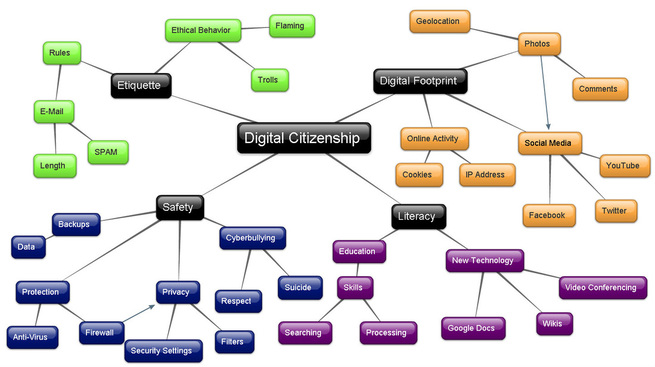
Digital Citizenship is a term that has many concepts associated with it. The concept map above shows just how many ideas can spawn from this one term. Ribble (2013) defines digital citizenship as the appropriate and responsible use of technology. Although this seems like a fairly simple definition, it is a very important one for students to understand and demonstrate. Similarly, Heick (2013) defines it as "[t]he quality of habits, actions, and consumption patterns that impact the ecology of digital content and communities" ("The Definition of Digital Citizenship").
At this age students are becoming more social, starting to transition from childhood to adolescence, and exploring the world around them in different,. more independent, ways. I think at this stage is is important to focus primarily on technology etiquette and the concept of a digital footprint.
Students at this age should be educated about what constitutes appropriate etiquette, because it is likely they will be actively participating in online activities, whether at home or in school. For example, providing an overview rules for e-mailing will help students when they are communicating with others. Additionally, knowing what digital footprint they are leaving behind is important for students to understand. If they are aware of what their digital footprint is then they are more likely to be responsible users.
For more information, THIS SITE from Microsoft offers valuable information regarding digital citizenship. It includes tips for educators, infographics, as well as fact sheets. THIS LINK has videos about digital citizenship that can be shown to students.
In conclusion, digital citizenship is a BIG topic that often generates more questions than answers. With an ever increasing online world practicing the fundamentals of digital citizenship is becoming more and more important.
References
Fig. 1. 9708873_orig.jpg. Retrieved on July 19, 2013. From http://joshuamorales.weebly.com/digital-citizenship.html
Fig. 2. digital-citizenship.jpg. Retrieved on July 19, 2013. From http://www.teachthought.com/wp-content/uploads/2013/04/digital-citizenship.jpg
Heick, Terry. (2013, May 2). The Definition of Digital Citizenship. Retrieved from
http://www.teachthought.com/technology/the-definition-of-digital-citzenship/
Microsoft. (2013). Safety and Security Center. "What does digital citizenship mean to you?" Retrieved from http://www.microsoft.com/security/resources/digital-citizenship.aspx
Ribble, Mike. (2013). Digital Citizenship: Using Technology Appropriately. Retrieved from http://www.digitalcitizenship.net/
Significant Comments:
http://joansjournal.weebly.com/1/post/2013/07/topic-9-web-awareness-ii.html#comments
http://aroseduc4764.weebly.com/1/post/2013/07/web-awareness-ii.html#comments

 RSS Feed
RSS Feed